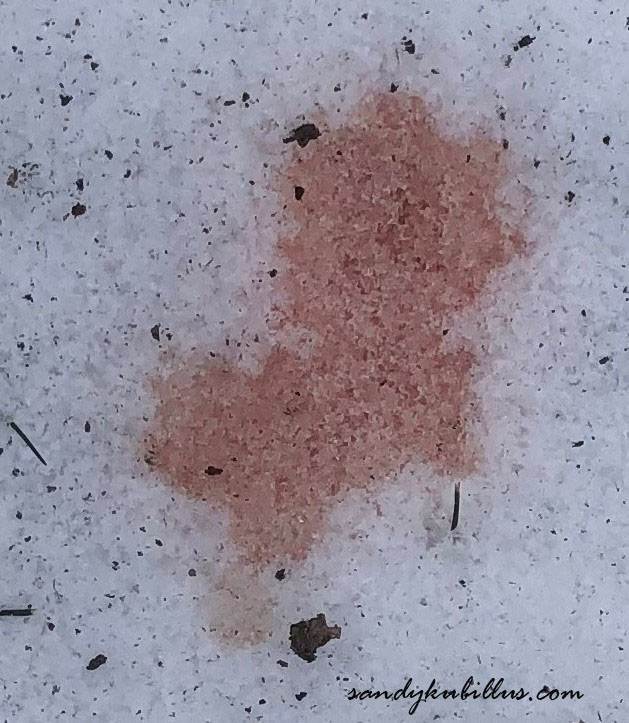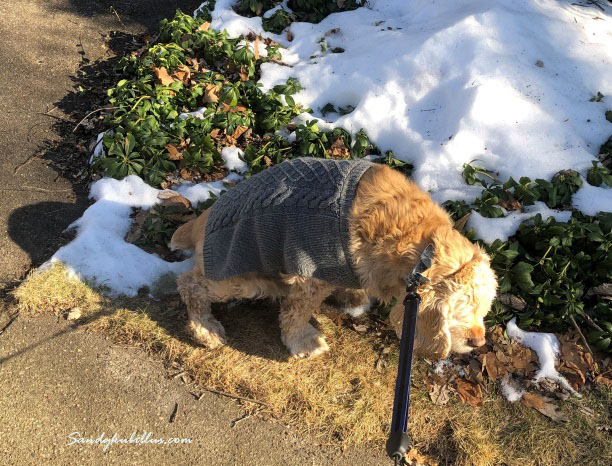My senior dog left pink spots on the snow after she peed. I knew instantly what it meant—she had blood in her urine, likely from a urinary tract infection.
My first thoughts were:
- Why did she get this?
- If I hadn’t walked her, I may not have caught it.
- If untreated, a UTI can lead to kidney infections and possibly even death—good thing I noticed!
You may be familiar with UTIs in people. The symptoms usually involve a burning sensation with blood in the urine, and a need to go often.
Buffy, my almost thirteen-year-old cocker spaniel didn’t seem to be in pain, nor was she licking her private parts (which she never does), nor was she asking to go out more often. If she had not peed in the snow, I likely would not have noticed this infection until it was much more serious. According to Dr. Buzby many UTIs, especially in female dogs, go undetected.
UTIs do not clear up on their own! See your veterinarian.
If left untreated, a UTI could lead to a blocked urethra, kidney infection, or worse, and there could be underlying health conditions.
Bacteria is the culprit for UTIs
It’s the middle of winter with nighttime temperatures near zero—bacteria should be dead! How could she get an infection? Surprisingly, bacteria can survive very cold temperatures.
A couple of ideas came to mind since I had just come back from a vacation where I had hired a neighbor to visit Buffy four times each day.
- Buffy often drags her butt on the ground after she poops. She never had a UTI before, but possibly because my neighbor did not pick up after her, she might have dragged her butt over her own poop.
- Fecal material is full of bacteria and is often a source of UTIs.
- Because there was snow on the ground, Buffy restricted her droppings to a limited area where I had shoveled.
- She is also blind, and her sense of smell seems weaker—factors that may have contributed to where she chose to “wipe” herself.
Walking your dog can help reduce UTIs
- I told the neighbor to let Buffy outside four times each day. She likely didn’t walk her. Typically I walk Buffy three times each day, no matter the weather – even if only for a few houses. Plus she gets let outside as needed.
- Flushing the bladder with plenty of water and frequent urination helps the body remove bacteria. Infrequent urination can allow bacteria to remain and accumulate.
- Not fully emptying the bladder can contribute to UTIs.
Female dogs are more likely to get UTIs
- Females have a much shorter urethra than males and the opening is very close to the anus, making it much easier for a female to get a UTI.
- Older female dogs often become leaky, especially when spayed. Buffy is on medication to control her bladder function. Possibly she had a leaking episode while I was on vacation which could have contributed to a UTI.
Lessons learned about UTIs
- It’s important to walk your dog AND to pay attention to their pee and poop!
- Don’t’ let poop accumulate in your yard. It’s a health hazard—even in the winter.
- Give your pet-sitter detailed directions and make sure they follow them.
- I can’t blame my neighbor for not walking Buffy. I later learned she was very ill and died two weeks later – I was shocked! I had no idea that she was sick.
How to identify a UTI
- Blood in the urine (red, pink, or cloudy urine)
- Excessive licking of their private parts
- Pain or straining to pee
- Increased need to urinate
- Dark urine or staining around the urethra
- Increased frequency of accidents in the house
- Frequently urinating small amounts (not scent marking during a walk)
- An unusual discharge from their urethra
Health conditions that may predispose your dog to UTIs
- Paralysis in the hind end where you have to manually discharge the bladder. When I had a paralyzed dog, she frequently got UTIs.
- Incontinence—especially if they urinate on themselves while sleeping.
- Clean your dog with pet bath wipes.
- Medications—Buffy takes Incurin tablets for her incontinence.
- Doggy diapers –I had a dog with cancer and the drugs (prednisone) made her leaky. She wore diapers for years and never had a UTI problem.
- Cushing’s disease
- Diabetes
- Any other issues related to the kidneys or bladder.
Prevention
If your dog has frequent UTIs, here are some options that may help prevent them
- Cleanliness – if your dog does not frequently clean herself, you may want to use doggie wipes.
- Make sure your pet adequately empties her bladder. Walking your dog several times a day helps.
- Pethonesty recommends cranberry supplements which may help improve bladder function and reduce urinary issues. Probiotics may also help.
Treatment
My vet inspected Buffy’s urine, confirming that she had a UTI. She prescribed an antibiotic. After two days, Buffy’s pee was no longer pink, and the infection was gone after she finished her ten-day antibiotic treatment.
Remember – untreated UTI’s can lead to serious conditions (WebMD).




Valuable info. Fortunate me I discovered your site by chance, and I am shocked why this coincidence didn’t took place in advance! I bookmarked it.
Long time no see! We’re glad Buffy is doing OK now. Thanks for the good information about UTIs.
Yes, it has been a long time. Being a teacher during the pandemic really set me back for a long time. Buffy is doing fine and will celebrate her 13th birthday in three weeks. I hope you are doing well.